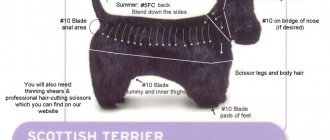How to tell when it's time to clean your dog's ears
Due to the small stature of dogs, their ears become dirty with dust, splashes from puddles, grass, and insects. It is extremely important to keep these organs clean, but hygiene cannot be done every day.
Sebum and wax are essential to protect the delicate epidermis inside the ears. They protect the organ from sudden temperature fluctuations, mosquito bites and bugs. By removing the beneficial layer, you can harm your pet and cause microtraumas, inflammatory processes, fungi and bacterial diseases.
Moderation is important in everything. In lop-eared dogs, dirt accumulates faster in the ears due to the lack of adequate air circulation. To determine whether it is time to remove wax, you need to lift the skin and look into the sink. For breeds with erect ears, it is sufficient to carry out an examination once every 2 weeks.
A simple test will help you accurately determine the need for a hygiene procedure. A moistened cotton swab or swab should be rubbed along the inside of the dog's hearing aid. If the instrument is clean, you can postpone the event. If a small yellow or dirty coating forms, you must wait a few days. Identification of large lumps of sulfur requires their immediate removal.
Beagle ear care
***
One of the important procedures for caring for beagles is regular inspection and cleaning of the pet's ears, since floppy ears are poorly ventilated, so breeders of the breed should know how to clean beagle ears correctly. To avoid problems and complications, your pet’s ears need to be inspected daily, cleaned regularly and massaged to ensure normal blood circulation. Not all dogs like this hygiene procedure, so it needs to be taught from an early age. During the summer, the pet's ears are examined twice a day, in the morning and after an evening walk.
The ears of a healthy pet should be clean, dry, and free of any strong odor, crusts, or redness. Normally, a small amount of brown discharge is allowed, which protects the ear canal from dust penetration, so if there is a small amount of discharge, it should not be removed daily. Beagle ears are cleaned 2-3 times a month or weekly, depending on the amount of wax produced.
When swimming, you should avoid getting water into your ears. You can insert cotton swabs or use ear powder for bathing, following the instructions for use. Remains of powder are cleaned out with a bandage or cotton wool an hour later or after bathing the dog or before bedtime.
Signs of inflammation:
- Redness, swelling.
- Sharp, unpleasant, specific odor.
- A large amount of earwax in the ear canal.
- Crusts on the inner surface of the ear.
- Restless behavior of the dog.
- The pet constantly scratches the sore ear, often shakes its head, does not allow the ear to be touched, and when pressure is applied, pain occurs and the dog whines.
If you have symptoms of otitis media in the early stages, you should immediately consult a veterinarian to prevent the disease from becoming chronic.
What to do if a tick is found in your ear?
Mites often appear in the ears. There is no need to panic, much less pour vegetable oil into the ear canal. In this case, special ear drops against parasites will help. If you don’t have any at hand, you need to grab the body of the parasite with ordinary tweezers, as close to the skin as possible and “unscrew” it in a circular motion. Disinfect the injection site with saline solution.
How to clean a beagle's ears
To clean the beagle's ears from dirt or plaque, use cotton swabs or ear cleaning sticks soaked in prophylactic lotion or saline solution, which can be purchased at veterinary pharmacies. You can also clean the beagle's ears using Vaseline or vegetable oil.
It is not recommended to use hydrogen peroxide or any alcohol solutions for cleaning, as they can injure and irritate the skin. There is no need to constantly use medicinal preparations and anti-inflammatory drops to clean the ears.
A small amount of the solution is dropped into the ear canal and the outer part of the ear is massaged for several minutes. Use a dry cotton swab to clean the entire inner surface of the ear. A new cotton swab is again moistened in saline solution and the surface of the ear is wiped again. Cleaning of the ear canal is carried out very carefully, trying not to go too deep inside, so as not to damage the tympanic septum. Do not use tweezers, forceps or cotton swabs to clean the ear canal. After the procedure, wipe the ear dry with cotton wool or a napkin and check that no pieces of cotton wool remain in the ear canal.
Use separate cotton swabs or swabs to clean each ear. If the pet constantly tries to break free, the dog is calmed down, encouraged with gentle words, and after the event, a favorite treat is given as a reward.
Importance of the procedure
Cleaning a dog’s ear is a disease prevention and a way to promptly detect disorders that require a veterinary examination and proper treatment. The appearance of an unpleasant odor is a signal of problems. It could be a mite, yeast-like fungi, or bacteria.
Expert opinion
Anna Abramenko
An avid dog lover. Experience in veterinary medicine since 2009.
Ask a Question
Cleaning your ears on time is important. The question concerns not only the aesthetic side, but also health. When a large amount of sulfur secretions accumulates, a dog may develop otitis media. Parasites are often associated with inflammation.
How often should the procedure be performed?
The younger the dog, the less often it needs to have its ears cleaned. The regularity of the procedure is also influenced by the pet’s lifestyle. If the animal is a “couch” breed and does not go outside often, it needs inspection and cleaning less often. Active dogs that go on walks a lot require more careful care.
Small erect ears may not need cleaning at all. It is enough to inspect them once a week for the presence of ear mites. For long-haired dogs and lop-eared dogs, it is advisable to clean the ears every other day.
To check whether your pet needs ear cleaning, you need to take a cotton swab and wipe it in one place on the outer part of the ear. If there is a barely noticeable grayish mark left on it, there is no need for cleaning. If traces of wax are clearly visible, it's time to clean your ears. On average, the procedure is carried out 1-2 times a month.
Look at the description of the Papillon dog breed, and also learn about the features of keeping a pet in a home.
General rules of therapy and effective methods of treating kennel cough in dogs are collected in this article.
Ways to clean your ears
There are different techniques. The scheme is almost always the same, the only difference is in the means used.
Professional drugs
The pet store offers a wide range of lotions and gels for gentle care of dogs' ears. Each product comes with instructions, but the procedure is roughly the same.
Cleaning principle:
- pull back the ear;
- pour 2-3 drops of product into the sink;
- hold the dog so that it does not shake its head;
- perform a light massage for better distribution of fluid along the walls;
- After 2 minutes, wipe the inside of the ear with a cotton pad or swab treated with the same cleaning agent.
It is forbidden to immerse hard devices deep into the dog's ear. This risks damaging the eardrum and causing further problems.
Folk remedies
Chamomile infusion, string, mint, tea leaves, etc. are used. The instructions for use have one distinctive feature - the liquid is prohibited from pouring into the ear.
How to clean:
- Cool the prepared infusion to room temperature;
- Wipe the sink and ear canal with a dry cotton swab or disk;
- moisten another clean instrument in the prepared solution;
- treat the inside and hollows of the ear;
- wipe the sink dry.
Chlorhexidine is a universal remedy
How to apply the product? This is a natural antiseptic, which, like hydrogen peroxide, is very often used in everyday life. They can cauterize wounds, treat severe cuts, and also disinfect the ears of pets. In addition, this procedure should be carried out after each cleaning for prevention.
But you should not clean your pet's ears with chlorhexidine. It can be used only in one case : when during the cleaning process you notice alarming signs of the development of the disease (redness, discharge and a strong, unpleasant odor), but there is no opportunity to visit a veterinarian and receive qualified help. Then you should drop a few drops into the dog’s ear and massage it gently. It is worth remembering that such a procedure will help relieve only a certain part of the symptoms, therefore, in order to completely eliminate the disease, you will have to undergo a full examination and course of treatment.
Frequency
The frequency of ear cleaning in different types of dogs depends on a large number of factors, among which a special place is given to the age of the pet and the structure of the hearing aid. Healthy puppies and young individuals undergo hygiene at intervals of 2-3 months. But this is an average value. To determine the need for the procedure, the following nuances must be taken into account:
- presence of heavy contamination;
- restless behavior, shaking the head, scratching the ears with paws;
- formation of scratches and wounds on the inner surface;
- accumulation of black plaque with a specific odor.
In these cases, it is recommended to carry out hygiene with chlorhexidine or miramistin. If after a short period of time wax or plaque has formed again, it is recommended to show the dog to a veterinarian.
Care products
The following options are suitable for carrying out hygiene procedures in the comfort of home:
- Wet wipes for dogs. Thanks to their softening impregnation, they effectively dissolve dirt and wax, but do not irritate delicate skin.
- Lotion. The most popular and sought-after cleaning product, capable of collecting all the secretions and removing them with a gentle massage or simple shaking of the head.
Expert opinion
Anna Abramenko
An avid dog lover. Experience in veterinary medicine since 2009.
Ask a Question
Lotions are not recommended for frequent use. Optimally – once a month. This medication is also contraindicated in dogs with perforated eardrums.
- Powder. A convenient option for hygiene of long ears. It dries out wax and absorbs moisture, which helps clean your dog’s hearing aid faster and more painlessly. Eliminates foul odor and kills bacteria.
- Cleaning drops. This product has several useful properties - disinfectant, medicinal, healing, antipruritic. They are used in the same way as lotions.
- Cotton buds. Replacement for gauze and tampons. They are impregnated with a solution, helping to better absorb moisture and remove dirt from the walls of the ears. It is recommended that the dog's ears be treated carefully with these devices to avoid injury.
If you don’t have professional products at home, you can clean your dog’s ears using the following liquids:
- Sea salt solution. Dilute 1 tsp in a glass of warm boiled water. salt, moisten the disc in this liquid and use it to remove deposits in the ear canal.
- Chlorhexidine. Pour a small amount of 0.5% antiseptic into each ear of the dog using a pipette; after a light massage, she should shake her head.
- Herbal infusions. Chamomile flowers and calendula have a healing, healing effect. They should not be put in the ears, but you can rinse them with a moistened swab or cotton swab.
- Green tea. Prepare a fresh drink, soak gauze or other device in it and use it to remove sulfur from inside the sink.
If a specific odor and itching appears from the ears, rinsing with hydrogen peroxide is recommended. Pour 5 drops of the 3% solution into each pass. For convenience, it is advisable to use a syringe without a needle for instillation. After the infusions, the dog will shake his head and everything will come out. Then the moisture is soaked with a dry towel.
How can you clean your dog's ears?
How to cut your Yorkie's hair at home yourself
The main question is what torments dog breeders, how to clean a dog’s ears and, most importantly, with what? In response to this question, most often the doctor prescribes washing with solutions of hydrogen peroxide, boric alcohol, saline solution, special lotions with a healing effect, saline solution, ear drops, special gels, powder, and lubrication with baby cream.
Attention! It is necessary to strictly follow the instructions of the specialist. Insufficient dilution of the medicine can burn the delicate skin and worsen symptoms. As a result of such injury, treatment may take longer.
Hydrogen peroxide is prescribed in rare cases. It can get on small wounds, hiss, and the pet will begin to panic and break free. Chlorhexidine is also a controversial drug. On the one hand, it is very effective, but on the other, it causes drying and aggravation of symptoms - the production of sulfur, inflammation. After treatment with this drug, you should moisten the ears or wipe them with moisturizers.
Also, sometimes the doctor prescribes treatment with antibiotics and antiseptics.
Folk remedies
Among the effective folk remedies recognized by veterinarians are:
- chamomile infusion;
- infusion of the series, symbolically called the infusion of the dog lover;
- mint;
- tea leaves;
- calendula infusion;
- sea salt solution;
- Sea buckthorn and other types of oils are sometimes used for moisturizing.
What not to use
The following remedies can leave a burn, injury, and irritate the thin epidermis in a dog’s ear:
- ethyl, food and boric alcohol;
- gel, shampoo, soap, etc.;
- vinegar essence;
- oil extracts.
Expert opinion
Anna Abramenko
An avid dog lover. Experience in veterinary medicine since 2009.
Ask a Question
The dog's ears should be carefully inspected and cleaned carefully. This is a sensitive organ that reacts with inflammation to various violations of hygiene.
Rules for cleaning ears
The procedure is carried out extremely carefully. It is important not to cause pain or discomfort to the dog, so that in the future it behaves calmly and trustingly waits for the end of the cleaning.
Step-by-step instruction:
- Wash the animal so that it calms down and relaxes.
- While stroking and praising, lay the dog on its side.
- Carefully lift your ear up.
- Inspect all depressions. If there is dried dirt, it should be moistened with the selected softening agent.
- After applying the drops, lotion or other drug, massage. Gentle rubbing movements will dissolve the wax and remove it from your dog's ear canal.
- Remove the residue with a cotton swab or swab previously soaked in the product.
How to get your dog used to ear cleaning
Some animals actively resist attempts to carry out hygiene procedures. This usually happens because the owner doesn’t clean the ears properly or doesn’t pay enough attention to raising the dog. You need to teach your dog to clean his ears from an early age.
The pet must get used to the fact that the owner carries out various manipulations with its limbs, teeth and ears. At the initial stage of training, you can simply touch the animal’s ears and massage them. It is extremely important to maintain the dog's trust and not cause him any discomfort. When the animal gets used to you, you can carefully begin the procedure of cleaning the ear canal.
Representatives of some breeds (for example, terriers) are extremely stubborn and do not allow their ears to be cleaned. The owner must show persistence and patience. He must, with the help of affection and food reinforcement, convince the animal of the need for hygiene procedures. Screaming and violent actions when communicating with an animal are not allowed.
You can also read our article: “How to wash a dog’s eyes at home”, how to properly care for your pet’s eyes, rinsing and hygiene products.











